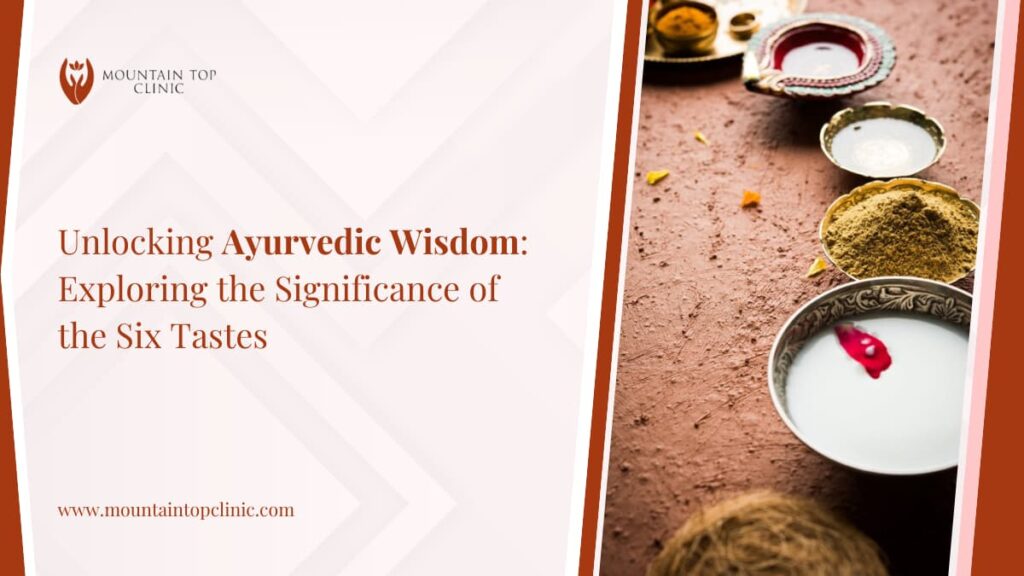
Do you have a sweet tooth? Do you dislike bitter foods like karela? Do you prefer your food to be spicy? While these questions may appear to be about personal flavor preferences, in Ayurveda, your taste buds hold the secret to understanding and balancing your Prakriti.
The ancient Ayurvedic scriptures speak about six tastes or six rasas. Rasa, in Sanskrit, means taste. Ayurveda promotes self-healing by balancing your dosha and rectifying any imbalance. Furthermore, it recommends modifying your diet according to the season to cope with seasonal changes and ward off seasonal diseases.
If you visit the best Ayurvedic clinic for treatment, the best Ayurvedic doctor in India will recommend dietary changes according to your Prakriti. In Ayurveda, food plays a significant role in balancing one’s health. In a balanced meal, all six tastes should be present on your platter to keep your Prakriti aligned.
We have outlined the qualities of these six tastes that should be part of your diet. However, before making any changes to your diet, it is important to consult with an Ayurvedic doctor to ensure these modifications are in line with your dosha and Prakriti./p>
What are the six tastes in Ayurveda?
The tridoshas, Vata, Pitta and Kapha, govern taste preferences; because of our dominant dosha, everyone enjoys a specific flavor or taste or a combination of tastes. Ayurveda recommends incorporating all six tastes into our meals, in the right combination and proportion, to unlock nutritional benefits and address health concerns. Let’s learn about these tastes.
1. Madhura (Sweet)
The sweet taste in Ayurveda is referred to as madhura. It is pleasant, comforting and nourishing. Carbohydrates, fats and proteins are the sources of sweet taste. This rasa calms the nerves, sustains bodily fluids and tissues.
As per Ayurveda, the sweet taste combines Earth and Water elements and effectively balances Vata and Pitta doshas. However, consume in moderation as it may aggravate Kapha dosha because of its heating and oily qualities. When consumed in moderation, it strengthens your body and promotes healthy skin and hair. It is advisable to incorporate this taste through natural resources such as fruits, rice, dairy, licorice and honey. Overindulging in sugary foods can cause weight gain, diabetes, coughing and it may even harm the body’s capacity to self-heal. However, if you are suffering from chronic diseases or other ailments, you should seek advice from a professional and before altering your diet, it is recommended to get the best Ayurvedic treatment in India for your underlying condition.
2. Lavana (Salty)
Lavana, or the salty taste, has a combination of Water and Fire elements. The qualities associated with this taste are heat, heaviness and oiliness. The salty taste can balance and heal the Vata dosha, but it is not recommended for the Pitta and Kapha doshas. The salty taste can aggravate the Pitta. Rock salt, table salt and other varieties of salts are some of the sources of this rasa, but mineral rock salt is considered to be the most beneficial due to the presence of essential minerals.
The Lavana Rasa promotes digestion, stimulates salivation and helps with waste elimination. However, excessive amounts of salt may spike your blood pressure levels and lead to issues like edema, ulcers and hair loss. It is advisable to stay away from processed, salty food items. Consult with the top Ayurvedic doctors in India to learn about the right proportion of salt for your diet.
3. Amla (Sour)
The sour taste combines Earth and Fire elements. The qualities associated with this taste are heaviness, warmth and stimulation. It is not ideal for the Pitta dosha, as it aggravates it. Curd, Indian gooseberry, lemon and tamarind are all a part of this taste group. These foods taste sour due to the presence of lactic acid, oxalic acid, citric acid, and ascorbic acid in some food items.
The sour taste moistens and stimulates saliva. The Amla rasa also promotes bile movement in the body, acts as an appetizer and boosts the body’s metabolism. Consuming an excessive amount of sour food may cause hyperacidity, aggravate wound infections and lead to sexual disorders. Consult with the best Ayurvedic doctor in India to learn the right way to consume this food group while maintaining balance in your doshas.
4. Katu (Pungent)
Katu rasa is the combination of Fire and Air elements. Pungent food items balance Kapha, but may aggravate Pitta and Vata in the long run. Its qualities are heat, lightness and dryness.
Food items in this group include chili peppers, mustard, black pepper, ginger and onion. If consumed in moderation, they aid in digestion, clear away blockages and are effective healers for conditions like sinusitis. The Katu rasa promotes vitality and vigor. It also helps break down fat in the body.
Excessive amounts of foods in this group may cause heartburn, diarrhea, colitis and peptic ulcers. It may also lead to aggression.
5. Tikta (Bitter)
The bitter taste in Ayurveda is known as the Tikta taste and has Air and Earth elements. The Tikta rasa influences the pancreas, liver and spleen. This rasa benefits the Pitta and Kapha doshas but will aggravate the Vata dosha. It has a cooling effect on the body.
The qualities associated with this taste are coolness, lightness and dryness. Herbs like karanja, turmeric, fenugreek and neem are bitter. Other bitter food items include coffee, karela and dark chocolate. The bitterness helps detoxify the blood, reduces sweat and prevents microbes from accumulating on the skin. For detoxification it is best to undergo an Ayurvedic detox Panchakarma treatment at the best Ayurvedic clinic.
6. Kshaya (Astringent)
The Kashaya taste, or astringent taste, combines Air and Earth elements. It has cooling, heavy and drying properties. It aggravates the Vata dosha but is helpful to Pitta and Kapha.
The taste is found in food items like okra, chickpeas, green beans, lentils, turmeric and raw vegetables. This rasa facilitates the absorption of nutrients and binding of stools in the system and has anti-diarrheal and anti-inflammatory properties.
Over consumption of astringent foods will lead to constipation, heart pain, insomnia and anxiety. However, consumption of raw vegetables is not advisable as it may lead to health problems in the long run. Awareness regarding each of these six tastes will help you understand their beneficial attributes as well as the consequences of overindulgence. Consuming these six tastes in the right proportion will benefit the body, mind and soul. Visit the best Ayurvedic clinic and consult with the best Ayurvedic doctor in India to learn more about your Prakriti and get more information on the best diet for your needs.

